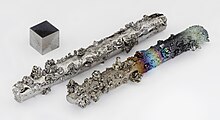టంగ్స్టన్, 00W |
|
| Pronunciation | (TUNG-stən) |
|---|
| Allotropes | α-tungsten (common), β-tungsten |
|---|
| Appearance | grayish white, lustrous |
|---|
|
|
| |
|---|
|
|
|
|
|
| Group | మూస:Infobox element/symbol-to-group/format |
|---|
| Period | period 6 |
|---|
| Block | d-block |
|---|
| Electron configuration | [Xe] 4f14 5d4 6s2[3] |
|---|
| Electrons per shell | 2, 8, 18, 32, 12, 2 |
|---|
|
| Phase at STP | solid |
|---|
| Melting point | 3695 K (3422 °C, 6192 °F) |
|---|
| Boiling point | 5828 K (5555 °C, 10031 °F) |
|---|
| Density (near r.t.) | 19.25 g/cm3 |
|---|
| when liquid (at m.p.) | 17.6 g/cm3 |
|---|
| Critical point | 13892 K, MPa |
|---|
| Heat of fusion | 35.3 kJ/mol |
|---|
| Heat of vaporization | 806.7 kJ/mol |
|---|
| Molar heat capacity | 24.27 J/(mol·K) |
|---|
Vapor pressure
| P (Pa)
|
1
|
10
|
100
|
1 k
|
10 k
|
100 k
|
| at T (K)
|
3477
|
3773
|
4137
|
4579
|
5127
|
5823
|
|
|
| Oxidation states | −4, −2, −1, 0, +1, +2, +3, +4, +5, +6 (a mildly acidic oxide) |
|---|
| Electronegativity | Pauling scale: 2.36 |
|---|
| Atomic radius | empirical: 139 pm |
|---|
| Covalent radius | 162±7 pm |
|---|
 Spectral lines of టంగ్స్టన్ Spectral lines of టంగ్స్టన్ |
|
| Natural occurrence | primordial |
|---|
| Crystal structure | body-centered cubic (bcc) |
|---|
| Speed of sound thin rod | (annealed) 4620 m/s (at r.t.) |
|---|
| Thermal expansion | 4.5 µm/(m⋅K) (at 25 °C) |
|---|
| Thermal conductivity | 173 W/(m⋅K) |
|---|
| Electrical resistivity | 52.8 n Ω⋅m (at 20 °C) |
|---|
| Magnetic ordering | paramagnetic[4] |
|---|
| Young's modulus | 411 GPa |
|---|
| Shear modulus | 161 GPa |
|---|
| Bulk modulus | 310 GPa |
|---|
| Poisson ratio | 0.28 |
|---|
| Mohs hardness | 7.5 |
|---|
| Vickers hardness | 3430 MPa |
|---|
| Brinell hardness | 2570 MPa |
|---|
| CAS Number | 7440-33-7 |
|---|
|
| Discovery | Torbern Bergman (1781) |
|---|
| First isolation | Juan José Elhuyar and Fausto Elhuyar (1783) |
|---|
| Symbol | "W": from Wolfram, originally from Middle High German wolf-rahm 'wolf's foam' describing the mineral wolframite[5] |
|---|
|
| Template:infobox టంగ్స్టన్ isotopes does not exist |
 Category: టంగ్స్టన్ Category: టంగ్స్టన్
| references |
References
These references will appear in the article, but this list appears only on this page.



